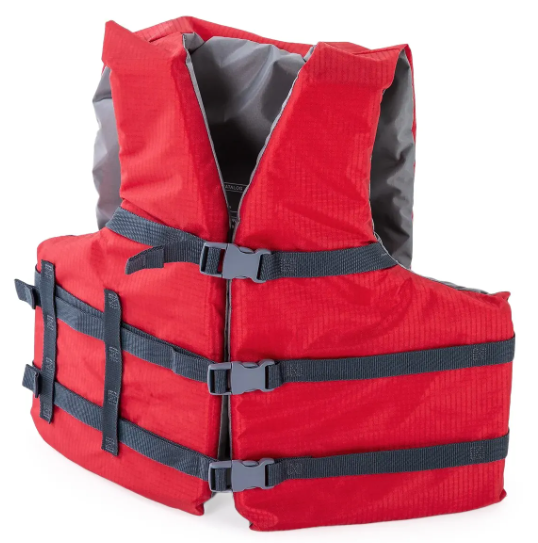How does a Life Vest save us?
Hey friends, Happy Wednesday!
Last week, I went to the Bring Your Own Big Wheels race in San Francisco.
Let’s look at how and why life vests work this week. I aim to write my newsletter issues in a way one can follow them while traveling on a bus, having a coffee, waiting for food, etc. Let's jump in!
How it works: 15-second answer
A life vest uses lightweight foam which traps air, making it less dense than water. According to Archimedes' principle, an upward buoyant force counteracts gravity and keeps us afloat by displacing water. Even though the vest adds a little weight, its volume increases significantly due to trapped air, making us less dense overall than water and buoyant when we wear it.
Answer to the question I posed last week
Last week, I asked what are the advantages and disadvantages of having a drone with just three fans. With three fans, we still have the problem of net torque by the fans on the drone body making them constantly spin about a vertical axis in general.
How and Why does a Life Vest work?
Let’s say I throw a ping pong ball on water. What do you think happens to the ball? It floats on water and doesn’t sink. But why does that happen?
Density = Mass of the Object / Volume of the Object
This is because of the difference in density between water and the ping pong ball. The ping pong ball is less dense than water and hence it can float. This applies to most of the objects with some exceptions.
Figure 1: Inherently buoyant Life Vest
So the reason we can partially float on water while wearing a life vest is that it makes us less denser overall compared to water. Hence, making us float and survive. What is so special in a life vest that makes this possible? Let’s explore.
Reason #1: The Life vest is filled with lightweight Foam and sometimes Kapok
The life vest is made of materials like Kapok and Foam which are way less dense than water.
Kapok is a lightweight, buoyant fiber obtained from the large woody seed pods filled with fluffy fibers of the kapok tree. They are hollow, which allows them to trap air efficiently thereby making them less dense. Most of the life vests used during the World War were made of Kapok. Foam is also used within a life vest for similar reasons. They are relatively inexpensive and a typical life vest during the recent times is mostly filled with foam.
Figure 2: Kapok fiber from the Kapok tree which is lightweight and buoyant.
Reason #2: Upward Buoyancy Force
In the example of a ping pong ball, if you try to push it into water, it forces and comes back up. Why is that so? According to Archimedes’ principle, when an object is placed in a fluid (such as water), it experiences an upward buoyant force equal to the weight of the fluid it displaces.
Now, if the object is less dense than the fluid (in this case, water), it will displace an amount of water that weighs more than the object itself. This means that the buoyant force acting on the object will be greater than its own weight, resulting in a net upward force that causes the object to float. This upward buoyant force helps counteract the force of gravity.
Reason #3: Less overall density (Human + Life vest) than water
But how does a life vest help us stay afloat while we’re wearing them?
Side Note: Our density is very close to the density of the water, that’s why some dead bodies float on water.
After wearing the lightweight life vest, our overall weight is almost the same, but volume is increased by a lot. So we become less dense (density = mass/volume) than water, making us float.
Figure 3: Man in water floating with a life vest as overall density is less than water
Overall weight increases only a little bit: The buoyant materials used in life vests are selected specifically for their ability to trap air and maintain buoyancy. Closed-cell foam, for example, traps air within its structure. This means that they are lightweight which doesn’t increase our overall weight when we wear them.
Overall volume increases a lot: However, the volume is very high as foam used in life vests traps a lot of air within its structure during its manufacturing process.
This makes us less dense than water (as density = mass/volume) and provides the necessary buoyant force to keep us afloat.
Reason #4: External covering that is resistant to water damage
Nylon (a synthetic fabric) is commonly used as an outer covering material for life jackets. It is lightweight, durable, and resistant to water damage. Nylon is often used in combination with foam or neoprene to provide additional strength and durability. The life vest design ensures that the buoyant force is evenly distributed around your body, further enhancing your ability to stay afloat.
Thus, these physics principles and material science come to the rescue and save us from drowning.
Question of the week
The life vests we discussed are inherently buoyant. What are some other types of life vests you have come across? Reply to this email with your thoughts, and we’ll discuss.
Gadget of the week
Home Robot: Ballie is a built-in AI robot with 2 wheels from Samsung, that greets you at the door. It has a built-in projector that can beam content on different surfaces. This includes welcome messages, workout videos, and video calls.
That's all folks. Thank you for reading!
Have an amazing rest of the week, and take care!
Until next to next Wednesday,
Chendur



